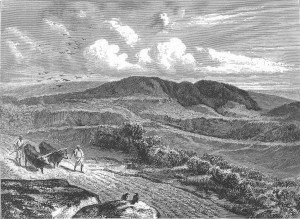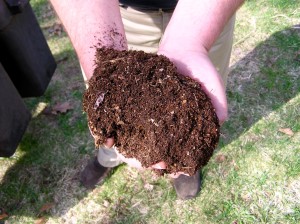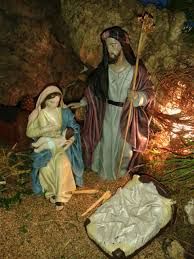What can we learn from the parable of the sower?
IT’S WORTH CONSIDERING

Sower Parable by Alexander Bida 1874
Many of us are very familiar with the parable of the sower found in Matthew 13:1-23. However, a closer look at the actual soil conditions in Israel and the way farmers really planted their seed gives new life to this familiar story. Put yourself in Jesus’ audience, standing on the shore of the Sea of Galilee as Jesus is teaching from a boat several yards offshore. He points to a farmer who is spreading seed not far from the crowd. He uses the farmer to tell a parable containing an eternal truth.
As Jesus progresses with the story, you see it acted out before your eyes. The farmer’s fields are typical for the region. Rather than being square or rectangular, they are long, narrow strips which have been cultivated by the farmer, and the ground between the strips is a commonly traveled path, often as hard as pavement. As you observe the farmer walking along this well-worn path and casting his seed onto the strips on either side, the typical breezes blow some of the seed away from the field and onto a variety of soils.
Jesus begins by directing your attention to the path the farmer is following. He refers to this common right of way as the wayside—the first type of soil He identifies. Any seed that landed on this path had as much chance of penetrating the soil as a seed that had fallen on pavement. Jesus then directs your attention to the seed that had been blown onto stony ground. This is not earth filled with rocks as we might expect. It is instead, a few inches of earth over an underlying shelf of limestone rock. Any seed landing here would germinate quickly because the soil, though thin, would quickly absorb the sun’s warmth. However, when the seed sent its roots in search of water and nourishment, it quickly reached the rock layer and was quickly starved to death.

Bishop Weed
The third type of soil Jesus describes is the thorny ground. This was the most deceptive of all the soils. It may be deep and “well-worked,” but it contained the unwanted and dormant roots of couch grass and bishop weed waiting to spring to life again. And when it did, it quickly overtook the good seed, springing up faster and stronger. The good ground, on the other hand, is deep, clean, soft, and well nourished. In this soil the seeds flourished and yields an abundant crop.
AS I SEE IT
Now for the important part—the types of hearers represented by the soils. Jesus’ point is that the same message will be received differently by different types of people, and He wanted those in his audience to be able to identify the soil that best represented them.
The first soil, the wayside, represented those whose hearts had become so hard that the truth Jesus was disseminating had almost no chance of taking root. What caused such a closed mind? Perhaps it was prejudice that rendered the person blind to everything he didn’t wish to see. Perhaps his pride has left him not knowing that he needs to know what he is hearing. Perhaps he is so set in his ways that he refuses to consider anything that goes against what he has decided is “his truth.” He may be trying so hard to justify his immoral behavior that he shuts out anything that may condemn him or his behavior. As a result, he has become unteachable and has become a living illustration of the axiom: there is none so blind as those who deliberately will not see.
needs to know what he is hearing. Perhaps he is so set in his ways that he refuses to consider anything that goes against what he has decided is “his truth.” He may be trying so hard to justify his immoral behavior that he shuts out anything that may condemn him or his behavior. As a result, he has become unteachable and has become a living illustration of the axiom: there is none so blind as those who deliberately will not see.
Then there’s the hearer with a mind like the shallow soil. This is the person who refuses to think through what he has just heard. He is a “flash in the pan.” He will quickly become enthused about something, but just as quickly lose interest. Perhaps things became difficult, or simply weren’t as much fun as they used to be. Perhaps his “new thing” simply became replaced by another “new thing.” Whatever the case, his life is littered with things he started but never finished. The initial feeling of excitement quickly dissipates. He does the same thing when hearing the Word of God. He may be nearly swept off his feet in an exhilarating emotional experience, but it soon fades. Instead of thinking his way through what he has heard, he lets his emotions take control, and is quickly disappointed when he no longer feels the excitement.
The third soil is the thorny ground, the deceptive soil. This represents the person who is so busy doing good things that the truly important things get crowded out. So many things demand his attention that he becomes worn out just keeping up with life. He has become too busy to pray and so preoccupied with so many things that he doesn’t ”’schedule in” time to study the Word. He has become so involved with his works of service that he leaves no time for the One he claims to love. He works for God and never with Him. Perhaps his business is so demanding that he is too tired to think about anything else. This is the most deceptive “soil” because everything this person is doing is a good thing. The problem is that he has let the good crowd out the best—that which God desires—an intimate relationship with Him.
 Finally, Jesus comes to the fourth soil, the good ground. Unlike the other soils, this man always has an open mind and is willing to learn, even if it contradicts what he believes. He is never too proud or too busy to listen. He has prepared his mind to hear and he comes ready to think through what he is about to hear. He takes notes whenever possible, so he can think through what he has heard. Perhaps most important of all, he understands. In response to his willingness to learn and to apply what he has learned, God has granted him understanding. This man listens, understands, and obeys, resulting in a great harvest for the kingdom.
Finally, Jesus comes to the fourth soil, the good ground. Unlike the other soils, this man always has an open mind and is willing to learn, even if it contradicts what he believes. He is never too proud or too busy to listen. He has prepared his mind to hear and he comes ready to think through what he is about to hear. He takes notes whenever possible, so he can think through what he has heard. Perhaps most important of all, he understands. In response to his willingness to learn and to apply what he has learned, God has granted him understanding. This man listens, understands, and obeys, resulting in a great harvest for the kingdom.
We all need to honestly determine which soil(s) represent us. We all need to be weeded, cultivated and fertilized, but the process will be so much quicker if we cooperate with our heavenly “Farmer” as He conforms us into the image of His Son.
YOUTUBE CHANNEL
Check out my YouTube channel to get my biblical analysis of current events and my suggestions for surviving and thriving while the world falls apart. Click the link or enter edrodgersauthor in the Youtube search box.
ATTRIBUTIONS
Inclusion of photographs and/or images in no way implies the endorsement of this newsletter or its information by the photographer or designer.
Bishop Weed photo by Lazaregagnidze
Attribution license https://creativecommons.org/licenses/by-sa/3.0/deed.e
Image of Sower Parable by Alexander Bida 1874 (Public Domain)






Leave A Comment